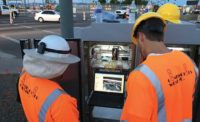In an effort to prevent train accidents on a new $2.3-billion, 10-mile-long extension line in San Francisco, the Berryessa-Valley Transportation Authority/Bay Area Rapid Transit (BART) team is installing a railroad intrusion-detection system (RIDS) that uses warning devices originally developed for protecting shipping ports from break-ins.
“We’re testing the system on a 5.2-miles stretch of track that runs parallel to the Union Pacific Railroad,” says Matt Shipman, systems engineering manager for PGH Wong Engineering Inc., San Francisco. Working on the project as part of the Santa Clara Valley Transportation Authority team, Shipman says this is the first application using a combination of tilt sensors on barrier fences and infrared cameras for intrusion detection on railroad track.
In addition to spotting intruders, the system also is designed to provide protection against accidents, such as the Amtrak derailment that occurred outside of Philadelphia last April, when a train struck a backhoe working beside the tracks, resulting in the deaths of two Amtrak workers and injuries to 35 passengers.
The system will identify a piece of equipment that finds its way onto BART’s tracks, and the trains will be issued an immediate halt command, says Timothy Schmidt, senior associate and director in northern California for Lockwood, Andrews & Newnam, the design manager.
“The infrared cameras are calibrated to identify and alert central control should the boom of a backhoe or other large object enter the site by going over the fence,” he says. During six months of demonstration tests, Schmidt and his team tossed large boxes and floated Mylar balloons over the fence to test the cameras and calibrate them for the sizes of the objects detected.
They also hurled 10-in. concrete block into the fence to test that the tilt sensors were performing. “We’ll do field-of-view tests, too, to make sure the cameras are capturing the largest part [of the area] possible. Then, we’ll do it with the train,” says Schmidt.
“If fences tilt, then the cameras goes [on] and you can replay it,” says Shipman. “The train will stop. Everything in that area will stop.”
Then, BART’s operating procedure will be to allow the train to move slowly enough through the jeopardized area that the train operator can safely make a visible inspection, says Shipman. “They’ll go through at six miles per hour to see if the tracks are clear. If the train operator sees something on the tracks, they’ll send someone to remove it,” he says.
The RIDS system is expected to go into full service in October.






Post a comment to this article
Report Abusive Comment